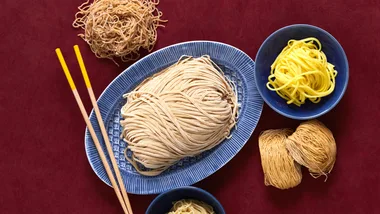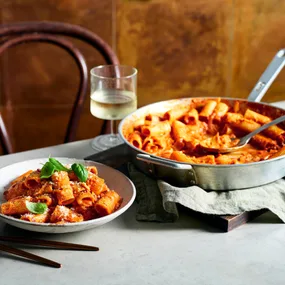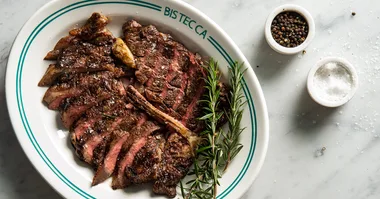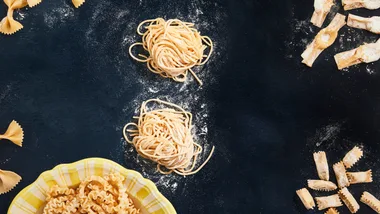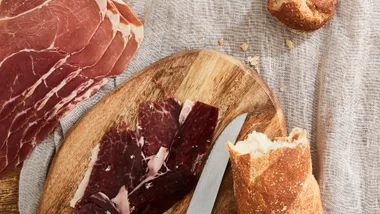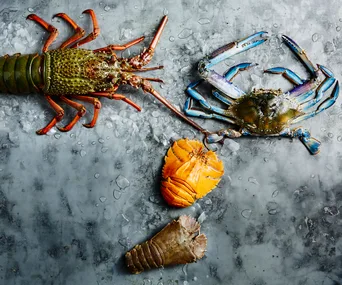It can be a messy business, this cooking with crabs – shrapnel and juice sprayed all over the kitchen, not to mention the time needed for the preparation. For some people, it’s a real turn-off; fortunately, high-quality picked fresh crab meat is readily available, mostly from blue swimmer or spanner crabs. But real crab enthusiasts understand the great rewards to be had from cooking crabs from scratch. The meat hand-picked at home is unrivalled for sweetness and juiciness, especially if you’ve chosen to go all out and cook the king of crabs, the magnificent mud crab.
Cooking live mud crab comes with a level of danger and excitement that’s all part of the fun. Yes, really. These are creatures with pincers that can take your finger out in one strike, so caution is most definitely required. I’ve witnessed a mud crab on the loose, scuttling over the kitchen floor with lightning speed the second after a cleaver missed its mark. The thing is, though, that all the trouble and the potentially squeamish moments are absolutely worth it. Those big pieces of rich, succulent meat are like no other seafood.
Always order from a top-quality, reliable supplier and cook the crabs the day you buy them because the meat (even in a live crab) deteriorates rapidly. I made the mistake once of ordering mine a couple of days ahead of time for a dinner. Instead of cooking them on the day they arrived, I kept them overnight, only to find they didn’t smell anywhere near as ocean-fresh the next day, and this came through loud and clear in the flavour of the finished dish.
How can you tell if a live crab is fresh? It should smell sweet, not acrid, and feel heavy for its size. It should be lively, and all its legs and claws should be attached (a crab will throw off its legs when it is in distress or decaying). Its eyes should be alert and pop up when it is handled.
Some people prefer crabs of a particular gender. The thinking is that males have more meat but that the flesh of the females is sweeter and their shells may contain the bonus of eggs, which are delicious stirred through noodles or pasta with the rest of the meat. You can tell the gender of a crab from the arrow shape on the underside of the body, which is wider on females and narrower on males.
To kill a crab humanely, refer to the RSPCA guidelines (search for “crustacean”). I find one large crab (around 800gm to 1kg) is enough for two people as an entrée or a small main. Remove the flap and lift off the top carapace, then pull off the gills and rinse the crab well under cold water. Chop the crab in half (I like to use a cleaver), then in half again, and crack the large claws. Steam in a steamer for about 6-10 minutes, checking the fattest part of the claw for doneness, then serve immediately.
My idea of a really lavish lunch is to order a couple of mud crabs, invite some friends around and enjoy steamed crab with crusty baguette, salty French butter, homemade mayonnaise and an aged bottle of Raveneau Chablis. Tuck your napkin into your collar, crack the shells and pick the meat out at the table.
Crab lends itself really well to Thai flavours. One of my favourite food and wine matches is a bottle of German riesling with a green mango, chilli and crab salad that’s dressed with nahm jim, fried shallots, roasted peanuts and lime: if you balance all the flavours carefully and don’t overdo the chilli, it’s a sublime combination.
Crab also goes beautifully with egg, be it bound in a little mayonnaise between slices of soft white bread with some finely cut cucumber as a decadent canapé, or in a crab omelette, à la Neil Perry, cooked in a wok with smoking-hot peanut oil, the eggs seasoned with a little fish sauce and sesame oil. The omelette will turn golden brown underneath and stay fluffy inside. When the eggs are just set, pour the oil off, fill the omelette with cooked crab meat and a few crunchy baby sprouts, roll it, and serve it with hoisin sauce. Oh yeah.
Crab tossed with spaghetti or linguine is another no-brainer, sautéed with extra-virgin olive oil, garlic, chilli and parsley. Using the best-quality artisan-made dried pasta makes all the difference in a dish such as this. A few good baby capers won’t hurt here either.
The last on my list of top things to do with live mud crab – and possibly my favourite when I have the time – is to steam it with Chinese black bean and chilli sauce. Making your own sauce is essential here; the shop-bought versions are too salty and overwhelming and can easily ruin the delicate sweetness of the crab meat.
 Antonia Pesenti
Antonia Pesenti

